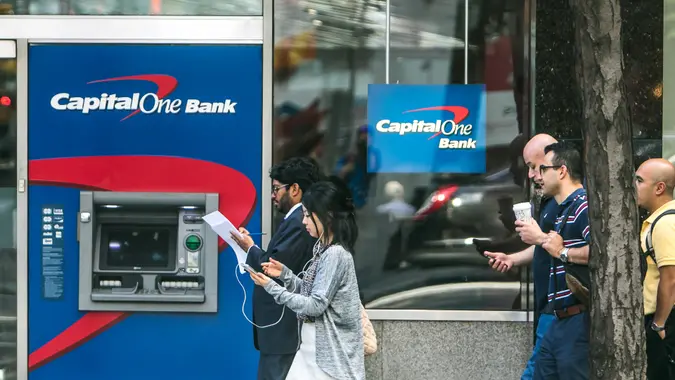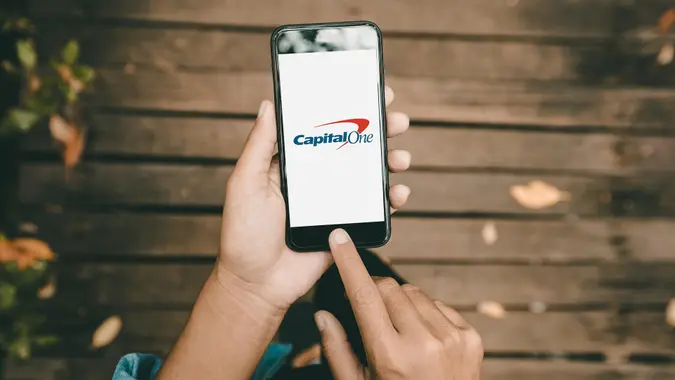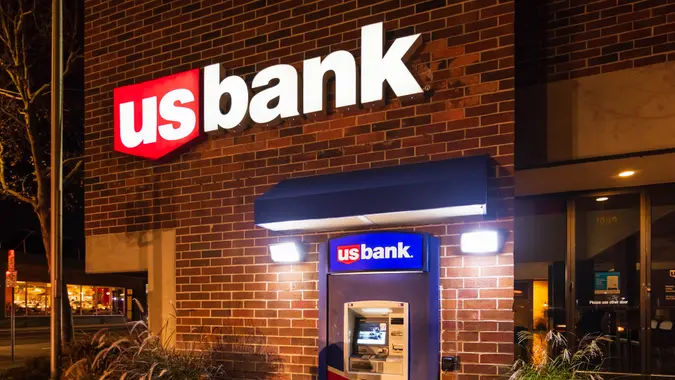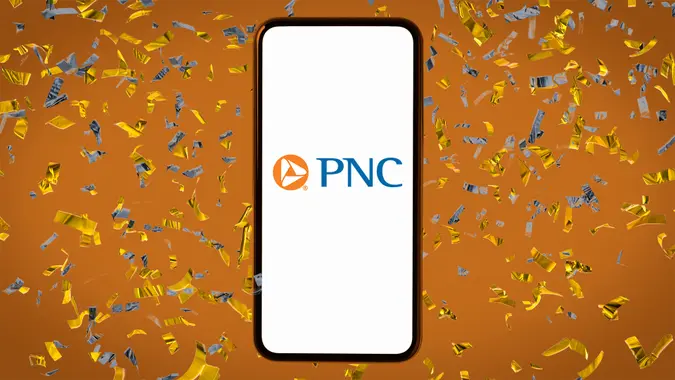Best Savings Accounts For Kids and Teens in 2024

Commitment to Our Readers
GOBankingRates' editorial team is committed to bringing you unbiased reviews and information. We use data-driven methodologies to evaluate financial products and services - our reviews and ratings are not influenced by advertisers. You can read more about our editorial guidelines and our products and services review methodology.

20 Years
Helping You Live Richer

Reviewed
by Experts

Trusted by
Millions of Readers
The relationship you have with money is formed at an early age. Emotional reactions and learning curves are attached to how you teach your child to spend money. Talking about money with your children and helping them form saving habits now could help them develop a healthy relationship with managing money later.
This is where savings accounts, including joint accounts, child accounts, custodial accounts and more come in. They can be a great way to share with your child some of the basics of the financial system, get them comfortable with banks and help them develop healthy spending and saving habits. It’s also a good tool to teach them about setting goals. Your children can start saving up money for the things they want to buy and learn early about how rewarding it is to reach those goals.
6 Best Savings Accounts for Kids in 2024
If you open a savings account for your child they will benefit from low minimum deposits, zero fees, low to no account balance requirements and a decent annual percentage yield. Some banks and credit unions also offer educational tools specifically for children which is helpful when choosing which bank account for kids is best for your child’s needs.
Banks with physical locations where children can interact with bankers and physically deposit money to open a bank account were given bonus points because children are more likely to have cash than money via direct deposit. The following list of best savings accounts for kids highlights the financial institutions most willing to be family-friendly and help jump-start a healthy relationship with money management.
- Northpointe Bank Kid’s Savings: Kids and teens who have serious savings goals.
- M&T Starter Savings Account: Children who will benefit from learning how to save with minimal emphasis on earnings.
- PNC S is for Savings: Young children who will benefit from the Sesame Street educational resources.
- Capital One Kids Savings Account: Kids who are interested in setting up online savings goals.
- Alliant Credit Union Kids Savings: Kids 12 and under due to account age restrictions.
- USAlliance Financial MyLife Savings for Kids: Best for smaller children looking for an above-average APY.
| Bank Account | Minimum Deposit | APY |
|---|---|---|
| Northpointe Bank Kid’s Savings | $10 | |
| M&T Bank Starter Savings | $0 | |
| PNC Bank S is for Savings | $0 | |
| Capital One Kids Savings | $0 | * |
| Alliant Credit Union Kids Savings | $5 | |
| USAlliance Financial MyLife Savings for Kids | $0 |
1. Northpointe Bank
The Kids Savings Account from Northpointe Bank offers a competitive APY. Plus, even though the APY drops for balances exceeding $1,000, the rates are still quite competitive.
Best For
Kids and teens who have serious savings goals.
Benefits
- High APY compared to other kids’ savings accounts
- No account maintenance or minimum balance fees
- Account can be set up in person or over the phone
Drawbacks
- Balances in excess of $1,000 earn a lower APY
- $10 fee if the account is closed within 120 days of the opening date
2. M&T Bank Starter Savings Account
The M&T Starter Savings Account offers account holders the option of using M&T’s Easy Save feature to automatically transfer money from an M&T checking to a savings account, which is great for teens who are earning a paycheck. Plus, the account has setup options that allow children to have full access.
Best For
Children who will benefit from learning how to save with minimal emphasis on earnings.
Benefits
- Automatic savings feature
- No minimum balance requirement
- No fees for users under 18
- You must visit a branch to open the account
Drawbacks
- Low APY
3. PNC S is for Savings
The PNC S is for Savings account is specifically for children and offered through PNC Bank. Its most unique feature is an online interactive experience for children featuring Sesame Street characters. The account also allows children to set savings goals.
Best For
Young children who will benefit from the Sesame Street educational resources.
Benefits
- Educational resource
- A wide availability of physical locations and ATMs
- No fees for users under 18
Drawbacks
- Low APY
- Minimum deposit required
- $5 fee if account holder is over 18 — waivable with a monthly balance of $300 or more
4. Capital One Kids Savings
A simple, no-fees account, Capital One Kids Savings offers an APY that applies to all balances with Capital One. It connects to parents’ accounts and offers a certain amount of easy parental control and oversight.
Best For
Kids who are interested in setting up online savings goals.
Benefits
- APY applies to all balances
- Wide network of ATMs
- No fees or minimums
- App connects to parents’ accounts and allows children to set up savings goals
Drawbacks
- Limited physical locations
- Lower APY than some other banks on the list
5. Alliant Credit Union Kids Savings
The Alliant Credit Union Kids Savings account is available for children 12 and under. Alliant Credit Union provides an easy, no-fee account with a high APY and parental control.
Best For
Kids 12 and under due to account age restrictions.
Benefits
- Good APY
- Joint management with parents
- No fees or minimums if you opt out of paper statements
- Alliant contributes first $5
Drawbacks
- Restricted to children age 12 and under
- Limited physical locations
6. USAlliance Financial MyLife Savings for Kids
Young savers will benefit from a competitive APY with no added maintenance fees or minimum requirements. Once your child turns 13, they can also add a checking account to access their money with a debit card. This is a great way to grow money management skills.
Best For
Smaller children looking for an above-average APY
Benefits
- Above average APY to help grow your child’s savings
- User-friendly convenience through both the mobile app and website
- Fun features, such as $10 in annual birthday bucks if your kid is 13 or younger
Drawbacks
- You can only earn the highest interest if a minimum of $500 deposited into the account.
- No linked ATM or debit card until after the age of 13
- Fewer educational tools than some competitors
Other Ways To Start Savings and Investments for Kids
Savings accounts are not the only options available for children. Here are some other ways to start savings and investments for kids.
CDs
Certificate of deposit accounts are FDIC-insured deposit accounts that typically earn higher interest rates than savings accounts. The downside of these accounts is that there is a fixed date of withdrawal, and until that date, you usually can’t access the funds without paying a penalty.
GOBankingRates’ guide to the Best CD Accounts explains the benefits and details of 2024’s best offerings.
Savings Bonds
Savings bonds are a way to earn interest by loaning money to the government. Bonds are sold at a fixed value, and the government pays you back with interest. You can ask for the money back at various times, but you get the most out of it if you wait until the bond fully matures.
It’s important to note that getting the money back is not exactly an instantaneous process.
Money Market Accounts
In a nutshell, money market accounts are another type of high-interest account. Although these accounts have certain restrictions, they often have check-writing features that some people might find useful. The downside is that money market accounts often require high minimum deposits.
Tips To Get Your Kids To Save
Kids can be motivated to save if you show them how they can benefit from waiting for interest to build and they can see how saving money helps them make bigger purchases.
Help Kids Save By
- Setting up different accounts for spending and saving
- Setting up savings goals — both small ones, like for a toy, and big ones, like for college
- Showing them how their money grows
- Teaching them about the financial system once they’re old enough to understand
Why You Should Open a Savings Account for a Child
- Financial education: Opening a savings account for your child teaches them valuable lessons about money, such as saving for goals, understanding interest and budgeting.
- Responsibility: Managing their own savings account gives children a sense of responsibility and ownership over their finances, fostering independence.
- Long-term savings habits: Starting early with a savings account helps children develop healthy saving habits that can benefit them throughout their lives.
- Financial security: Teaching children to save money provides them with a financial safety net and prepares them to handle unexpected expenses or emergencies in the future.
- Goal setting: Savings accounts encourage children to set savings goals, whether it’s for a new toy, a college fund or a charitable donation, teaching them the importance of setting and achieving financial objectives.
- Parental guidance: Many kids’ savings accounts offer parental controls and monitoring tools, allowing parents to guide their children’s financial decisions and provide valuable guidance on money management.
Final Take
Saving accounts are a great tool for introducing children to finances. With many options available, you can choose the account with the features that best suit your priorities, such as physical locations or high APY. The most important thing is to look for an account with no fees and low minimums to avoid your children getting charged for having a low balance.
FAQ
- Which savings account is best for a child?
- An account that earns interest so a child can see the benefits of setting money aside is ideal. Look for accounts that allow you, as the parent, to monitor your kid's activity.
- Is it a good idea to open a savings account for a child?
- Opening a savings account is a great idea to teach children about saving money and how banks work. Be sure to choose a bank that offers no-fee accounts for kids that pay interest.
- Can a 10-year-old have a savings account?
- Minors can have a savings account at many banks. However, a parent and joint account holder will be required.
- Can I open a high-yield savings account for my child?
- Most banks offering high-yield savings accounts will allow you to open one on behalf of your child.
Caitlyn Moorhead, Daria Uhlig and Cynthia Bowman contributed to the reporting for this article.
Rates and fees are subject to change; unless otherwise noted, rates are updated periodically. All other information on accounts is accurate as of Oct. 10, 2024.
*Savings vary depending on account usage and payment behavior. Capital One interest rates accurate as of Oct. 10, 2024. See website for all current rates.
Editorial Note: This content is not provided by any entity covered in this article. Any opinions, analyses, reviews, ratings or recommendations expressed in this article are those of the author alone and have not been reviewed, approved or otherwise endorsed by any entity named in this article.
GOBankingRates is a personal finance and consumer interest rate website and an online marketing company serving top-tier banks, credit unions and other financial services organizations. Some companies mentioned in this article might be clients of GOBankingRates, which serves more than 100 national, local and online financial institutions. Rankings and roundups are completely objective, and no institution, client or otherwise, paid for inclusion or specific placement. Any opinions, analyses, reviews or recommendations expressed in this article are those of the author alone and have not been reviewed, approved or otherwise endorsed by the companies included in the article. All fees and rates are subject to change at the issuers’ discretion. Some interest rates might be short-term or promotional offers only, and it is possible additional terms and conditions must be met to obtain the interest rates listed. Rates and availability might vary by region. Verify terms and conditions before opening an account.
GOBankingRates bases its assessment of “best” and “top” products on the above-stated parameters to create a baseline for comparison. This assessment is an approximation of “best” and “top” designed to help consumers find products that might be appropriate for them. There could be other options available as well. Consumers should consider various options appropriate for their circumstances.
Our in-house research team and on-site financial experts work together to create content that’s accurate, impartial, and up to date. We fact-check every single statistic, quote and fact using trusted primary resources to make sure the information we provide is correct. You can learn more about GOBankingRates’ processes and standards in our editorial policy.
- University of Michigan. "Spendthrift or tightwad? Children form attitudes about money at young age."
 Written by
Written by  Edited by
Edited by 




























